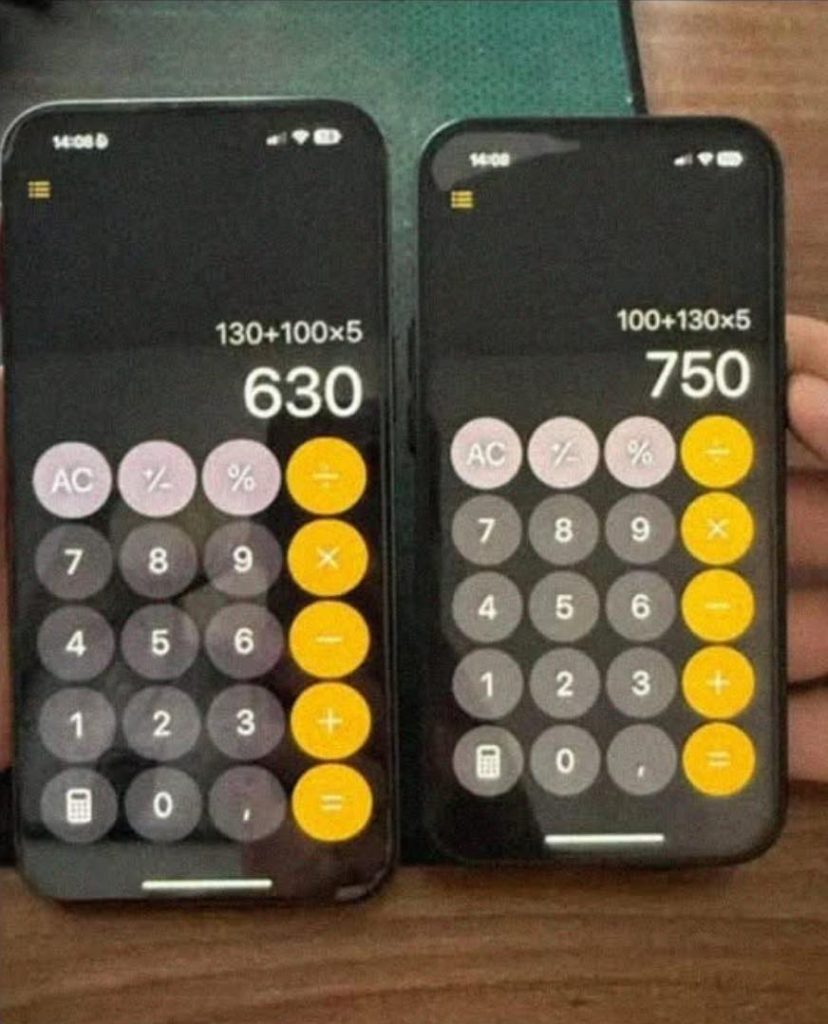Why This Viral Calculator Puzzle Has Everyone Scratching Their Heads
Ever seen two identical-looking calculations give two completely different answers? That’s exactly what’s happening in the viral photo above. Two phones. Two calculator apps. Two results. One says 630, the other says 750.
At first glance, it seems like something must be broken, right? A bug? A glitch? A mistake?
Well, not quite.

In fact, both answers are absolutely correct—and once you understand why, you’ll be amazed by how your brain can be tricked by something so simple. So before you scroll down for the answer, take a moment to test yourself.
Look closely at both equations. Can you figure out what’s going on?
Drop your answer in the comments before reading further—no cheating!
The Common Mistake That Catches Most People
Here’s the thing: most of us read numbers and operations like we read a book—from left to right. So when we see something like:
130 + 100 × 5
We naturally want to start with 130 + 100, then multiply the result by 5. But that’s not how math works.
There’s a set of rules we have to follow, and this particular riddle is a classic reminder of just how easy it is to forget them in casual settings. Especially when you’re using a calculator that doesn’t show the full equation all at once!
This puzzle plays off a very common mistake: ignoring the order of operations. You might remember learning PEMDAS in school, but let’s be real—most of us forget it the second we graduate.
Video : iPhone Calculator Confuses Everyone Again
Solving the Puzzle: A Step-by-Step Walkthrough
Let’s break this down one phone at a time.
Left Phone: 130 + 100 × 5
This is the calculation shown on the phone on the left.
Step 1: Recognize the equation
The full input is: 130 + 100 × 5
Step 2: Apply the order of operations (PEMDAS)
PEMDAS stands for:
P – Parentheses
E – Exponents
MD – Multiplication and Division (left to right)
AS – Addition and Subtraction (left to right)
Multiplication comes before addition, so we can’t just go from left to right.
Step 3: Multiply first
100 × 5 = 500
Step 4: Add second
130 + 500 = 630
So the left phone is correct. ✅
Right Phone: 100 + 130 × 5

Now let’s look at the phone on the right.
Step 1: Understand the new input
This one shows: 100 + 130 × 5
Step 2: Follow the same order of operations
Again, multiplication before addition.
Step 3: Multiply first
130 × 5 = 650
Step 4: Add second
100 + 650 = 750
So the right phone is also correct. ✅
So What’s the Trick Here?
It’s not about the phones—it’s about what you typed in.
Both calculators followed the correct math rules. They simply produced different results because the numbers were input in different orders. The photo is showing two different equations, even if the numbers look similar at first.
This is where many people get fooled. We tend to assume we’re looking at the same formula twice—and when we see different answers, we think something went wrong.
But this puzzle is a great reminder: in math, the order of operations matters more than the order of the numbers.
Video : Solving 8÷2(2+2) With Two Different Calculators – Each Calculator Gives a Different Answer
Why Do People Get This Wrong?
There are a few key reasons:
- We default to left-to-right thinking.
Most of us aren’t trained to scan for operations before acting. We see “130 + 100 × 5” and just go straight from the beginning. - Calculators don’t always show parentheses.
If you’re typing quickly, or you’re not using an advanced calculator, it won’t display the entire structure of the equation. That’s where misunderstanding creeps in. - The math looks “easy.”
This isn’t calculus or algebra. It’s basic arithmetic—which makes it even easier to overlook something.
Takeaway: Order Is Everything
Let’s say this again for the people in the back: Multiplication always comes before addition—unless you use parentheses to override it.
Want 130 + 100 to be added before multiplying by 5? You’d need to write it like this:
(130 + 100) × 5 = 230 × 5 = 1150
But that’s not what happened here.
In the left example, it’s 130 + (100 × 5) = 130 + 500 = 630
In the right example, it’s 100 + (130 × 5) = 100 + 650 = 750
Different structure. Different results. Same rules.

Your Turn: Can You Outsmart the Puzzle?
Now that you know the answer, go back to the image and look again. Do you see the difference more clearly now?
More importantly—did you get it right the first time? Or did you fall into the classic left-to-right trap?
We’d love to hear from you.
👉 Share your first guess in the comments
👉 Tag a friend and challenge them to solve it
👉 Try explaining the answer to someone else—it’s a great way to lock it into memory
Try More Puzzles, Train Your Brain
These kinds of puzzles may seem simple, but they’re powerful. They train your brain to slow down, spot details, and apply logic—skills that are useful far beyond math.
So next time you see a calculator puzzle, a logic riddle, or a brain teaser, don’t skip it. Dive in. Get it wrong. Learn why. And get it right next time.
Because the more you train your brain to look deeper, the sharper it becomes.
And who knows? Maybe next time, you’ll be the one explaining the puzzle to someone else.